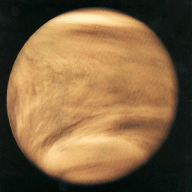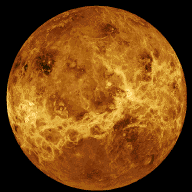

|
Astronomy 161:
An Introduction to Solar System Astronomy
Prof. Richard Pogge, MTWThF 2:30
|
Lecture 34:


Venus Unveiled
Key Ideas:
Venus is the second planet from the Sun
- Nearly the same size as the Earth
- Covered with opaque clouds
- Slow retrograde rotation
Atmosphere:
- Hot, heavy CO2 atmosphere
- Runaway Greenhouse effect
Surface: mapped using Radar
- Rolling plains, highlands & valleys
- Unique terrain features
Venus at a Glance
- Orbital Data
- Semi-Major Axis: a = 0.723 AU
- Orbital Period: 224.7 days
- Eccentricity: e = 0.007 (Most circular orbit of the planets)
- Inclination: i = 3.39°
- Planetary Data
- Radius: R = 6052 km (0.949 REarth)
- Mass: M = 0.815 MEarth
- Rotation: 243.02 days Retrograde!
- Axis Tilt: 177.4°, Upside down!
Spacecraft Visits
- Flybys:
- Mariner & Pioneer satellites (1962)
- Landers:
- Venera 7 (1970 - USSR) - first soft landing
- Atmospheric Probes:
- Pioneer Venus (US: 1978)
- Vega 1 & 2 balloon probes (USSR: 1985)
- Orbiters:
- Pioneer Venus Orbiter (US: 1978)
- Venera 15 & 16 (USSR: 1983)
- Magellan (US: 1990-1994) - most detailed radar mapping
- Mars Express (ESA: 2005-present)
The ESA Venus
Express spacecraft, is currently in orbit around Venus studying its
atmosphere.
Veiled Venus
Venus is completely covered by a thick planet-wide layer of opaque
clouds.
First data about the surface came from radar signals bounced off Venus:
- Revealed the very slow, retrograde rotation of the planet.
- Radiometry revealed that the surface was very hot, upwards of 700 K!
Retrograde Rotation
Venus has a slow, retrograde (east-to-west) rotation.
- Rotation Period is 243 Days
- This is unusually Slow
Possible Causes:
- Tidal interaction between Venus, Sun, & Earth with
complex braking by the atmosphere.
- Massive glancing impact virtually de-spinning Venus and
making it go slowly backwards.
Venus' Atmosphere
Composition:
- 96% Carbon Dioxide (CO2)
- 3.5% N2
- 0.15% Sulfur Dioxide (SO2)
- <0.1% Water Vapor (bone dry!)
Surface Pressure: 90 atmospheres
- Like ocean at a depth of ~1 km
Surface Temperature: uniform 750 K (891º F)
Sulfuric Acid Clouds
The clouds of Venus are not water vapor clouds like on Earth:
- Consist mostly of droplets of Sulfuric Acid (H2SO4).
- Forms a thick layer between 48 and 58 km altitude.
Lower atmosphere and surface are clear below the H2SO4
cloud deck.
- Get optical distortion of the horizon from the hot, heavy atmosphere.
Runaway Greenhouse Effect
Venus is so hot (750K) because of a runaway greenhouse effect:
- Hot, heavy CO2 atmosphere, 100x heavier than
the Earth.
- Heat trapping make Venus about +500K hotter than it would
be with no atmosphere.
- Water stays in vapor form, and is eventually broken into
H2 and O by UV photons.
- H2 escapes into space and is lost.
The result is that Venus is extremely dry today with very little
water!
Venus Unveiled
The surface of Venus has been mapped using imaging radar.
- First global map was made in 1978 by the Pioneer Venus
orbiter
- Venera 15 & 16 radar imagers (low resolution)
Highest Resolution Map:
- Magellan Venus (1990-1994)
- 98% of the surface at 120-300 meter resolution
- Good enough to do geological assessment
The Surface of Venus
Terrain:
- ~85% rolling planes
- ~15% highland plateaus & mountain belts
Highlands are concentrated into two regions:
- Ishtar Terra
- Aphrodite Terra
These are not ancient highlands like the Moon & Mercury.
Also identified impact craters, volcanoes, and other geological
features.
Volcanism & Geologic Activity
Volcanoes are a common terrain feature:
- None in chains, suggesting no plate tectonics
- Pancake domes & coronae 100-200 km across
- Are some volcanoes active today??
Tectonics, but not plate tectonics:
- High temperatures makes the crustal rock soft.
- Upwelling material from the mantle.
- Downwelling causing compression.
Impact Craters
Only ~1000 Impact craters are seen on Venus:
- Randomly scattered around the surface.
- None <3km across (meaning no impacts by meteors <30m across,
smaller meteors probably burn up in the heavy atmosphere before the
reach the ground)
- ~80% of the surface has been repaved in the last 500 Myr.
Two competing ideas:
- Craters get filled in by volcanoes very quickly.
- Catastrophic volcanic repaving of the entire surface ~500
Myr ago.
Venus & Earth
Volcanic & tectonic repaving:
- Earth: on-going process
- Venus: most repaving occurred ~500 Myr ago
Tectonic activity is different:
- Earth: lateral recycling from sliding motions of
tectonic plates.
- Venus: vertical recycling via upwelling &
downwelling.
This difference may be related to lack of water in Venus' crust,
which makes it more pliable than the Earth's crust.
Atmospheres reflect differing histories:
- Earth: Warm, light, moist N2 & O2
atmosphere with liquid of water.
- Venus: Hot, heavy, dry CO2 atmosphere, and no
water in any form.
Why the differences, given that they had the same starting point
(volcanic outgassing of CO2 & H2O)?
- Venus experienced a runaway greenhouse effect due to greater solar
heating than the Earth.
- This drove away all of its water, so there were no oceans in which
CO2 chemistry could occur to lock up CO2 into
crustal rocks.
Return to [
Unit 6 Index
|
Astronomy 161 Main Page
]
Updated: 2007 November 4
Copyright © Richard W. Pogge,
All Rights Reserved.

